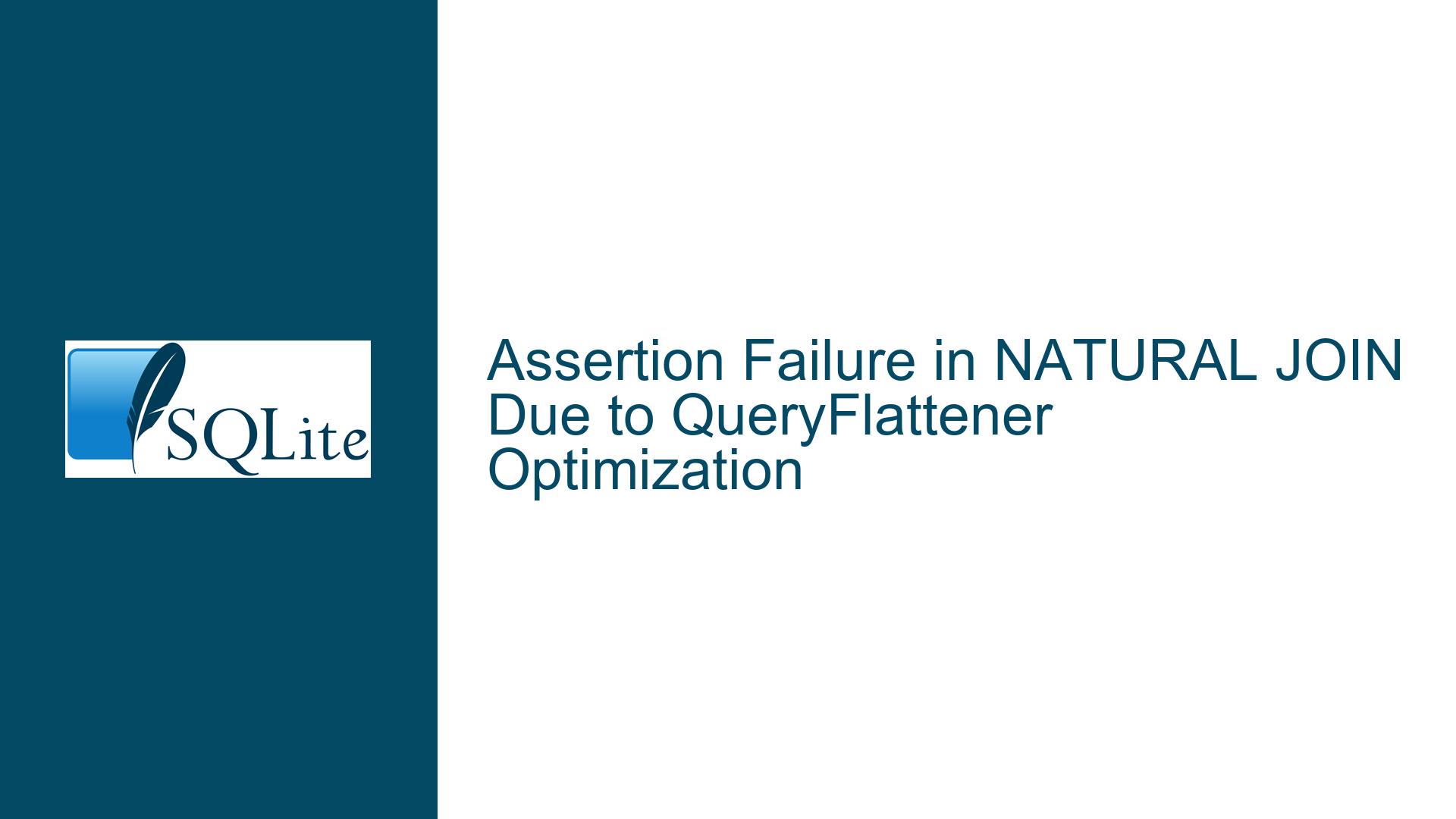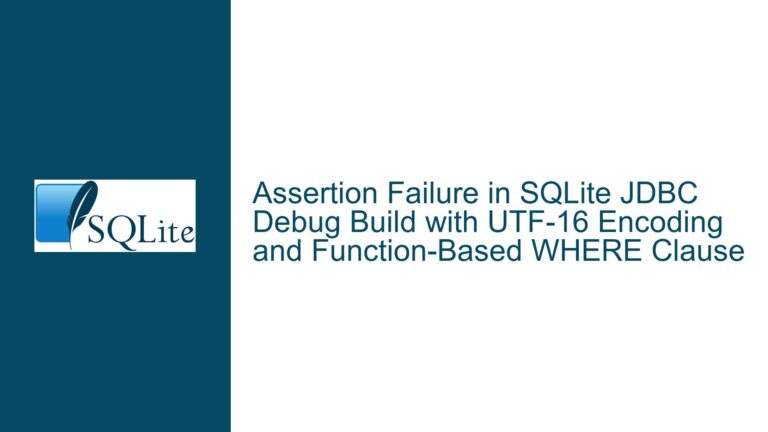Assertion Failure in NATURAL JOIN Due to QueryFlattener Optimization
Issue Overview: Assertion Failure in NATURAL JOIN with QueryFlattener Optimization
The core issue revolves around an assertion failure in SQLite when executing a specific query involving a NATURAL JOIN between a table and a view. The failure occurs in the sqlite3VdbeExec function, specifically at the assertion memIsValid(&aMem[pOp->p1]). This assertion ensures that a memory cell (aMem) referenced by the virtual machine operation (pOp->p1) is valid before proceeding. When this assertion fails, SQLite aborts execution, resulting in a crash.
The problematic query involves a table v0 with a primary key defined with a COLLATE nocase clause and a redundant UNIQUE constraint on the same column. A view v1 is then created, which selects the column c0 from v0 using a subquery. The NATURAL JOIN between v0 and v1 triggers the assertion failure. The issue is reproducible with the latest version of SQLite (commit 787291414d2d2082) and is linked to the SQLITE_QueryFlattener optimization. Disabling this optimization resolves the crash, indicating that the optimization is directly involved in the failure.
The bug was introduced in a specific commit range, as identified by bisecting the SQLite source code. The faulty behavior was observed starting from commit 198b3e33dcfd74c7 and persisted until commit e72661eb680ea707. The issue was later fixed in commit c104e5c6eeb89575.
Possible Causes: QueryFlattener Optimization and Invalid Memory Access
The assertion failure is likely caused by an invalid memory access during the execution of the NATURAL JOIN operation. The SQLITE_QueryFlattener optimization, which is designed to simplify nested queries by flattening them into a single query, appears to mishandle the specific structure of the query involving the view v1. This mishandling results in an invalid memory reference, causing the assertion memIsValid(&aMem[pOp->p1]) to fail.
The root cause can be traced to the interaction between the NATURAL JOIN operation and the SQLITE_QueryFlattener optimization. The NATURAL JOIN operation attempts to match columns with the same name between the table v0 and the view v1. However, the view v1 is defined using a subquery that selects the column c0 from v0. This subquery introduces a layer of complexity that the SQLITE_QueryFlattener optimization fails to process correctly, leading to an invalid memory reference.
Additionally, the schema design of the table v0 may contribute to the issue. The table v0 has a primary key defined with a COLLATE nocase clause and a redundant UNIQUE constraint on the same column. This redundancy, while syntactically valid, may introduce edge cases that the query optimizer does not handle properly. The combination of the COLLATE nocase clause and the redundant UNIQUE constraint could create ambiguities in how the NATURAL JOIN operation matches columns, further exacerbating the issue.
The compilation flags used during the build may also play a role in exposing the bug. The flags -DSQLITE_DEBUG, -DSQLITE_ENABLE_TREETRACE, -DSQLITE_ENABLE_WHERETRACE, -DSQLITE_ENABLE_CURSOR_HINTS, -DSQLITE_COUNTOFVIEW_OPTIMIZATION, and -DSQLITE_ENABLE_STAT4 enable various debugging and optimization features that could influence the behavior of the query optimizer. These flags may make the bug more apparent by providing additional checks and traces that highlight the invalid memory access.
Troubleshooting Steps, Solutions & Fixes: Debugging and Resolving the Assertion Failure
To troubleshoot and resolve the assertion failure, follow these detailed steps:
Step 1: Reproduce the Issue
Begin by reproducing the issue using the provided schema and queries. Create the table v0 with the specified primary key and unique constraints, insert a row into v0, create the view v1, and execute the NATURAL JOIN query. Ensure that the SQLite binary is built with the same compilation flags to replicate the exact environment where the bug occurs.
Step 2: Disable QueryFlattener Optimization
If the assertion failure occurs, disable the SQLITE_QueryFlattener optimization using the .testctrl optimizations 0x00000001 command. This command disables the specific optimization responsible for the crash. Re-run the NATURAL JOIN query to verify that the issue is resolved. This step confirms that the SQLITE_QueryFlattener optimization is the root cause of the problem.
Step 3: Analyze the Query Execution Plan
Use the EXPLAIN QUERY PLAN statement to analyze the execution plan of the NATURAL JOIN query. Compare the execution plan with and without the SQLITE_QueryFlattener optimization enabled. Look for differences in how the query is processed, particularly in how the view v1 is handled. This analysis can provide insights into why the optimization fails and how it affects the query execution.
Step 4: Review the Schema Design
Examine the schema design of the table v0 and the view v1. Pay special attention to the COLLATE nocase clause and the redundant UNIQUE constraint on the column c0. Consider whether these design choices are necessary or if they can be simplified to avoid potential ambiguities. Test alternative schema designs to see if they resolve the issue without disabling the SQLITE_QueryFlattener optimization.
Step 5: Update to the Fixed Version
If the issue persists, update to a version of SQLite that includes the fix for this bug. The bug was fixed in commit c104e5c6eeb89575, so ensure that the SQLite binary is built from a source code version that includes this commit or later. Verify that the NATURAL JOIN query executes without assertion failures after the update.
Step 6: Enable Debugging and Tracing
If further investigation is needed, enable additional debugging and tracing features using the compilation flags -DSQLITE_DEBUG, -DSQLITE_ENABLE_TREETRACE, and -DSQLITE_ENABLE_WHERETRACE. These flags provide detailed traces of the query execution process, which can help identify the exact point where the invalid memory access occurs. Analyze the traces to pinpoint the cause of the assertion failure.
Step 7: Submit a Bug Report
If the issue is not resolved by the above steps, submit a detailed bug report to the SQLite development team. Include the schema, queries, compilation flags, and any relevant traces or logs. Provide a clear description of the issue and the steps taken to reproduce it. The SQLite team can use this information to further investigate and address the bug.
Step 8: Implement Workarounds
While waiting for a fix, implement workarounds to avoid the assertion failure. One workaround is to disable the SQLITE_QueryFlattener optimization as described in Step 2. Another workaround is to rewrite the query to avoid using NATURAL JOIN or to simplify the view v1 to eliminate the subquery. Test these workarounds to ensure they resolve the issue without introducing new problems.
Step 9: Monitor for Future Updates
After implementing a workaround or updating to a fixed version, monitor for future updates to SQLite. The SQLite development team regularly releases updates that include bug fixes and performance improvements. Stay informed about new releases and apply updates as needed to maintain a stable and secure database environment.
Step 10: Document the Resolution
Finally, document the resolution process, including the steps taken, the findings, and the final solution. This documentation serves as a reference for future troubleshooting and helps others who may encounter similar issues. Share the documentation with your team or community to contribute to the collective knowledge base.
By following these detailed troubleshooting steps, you can effectively diagnose and resolve the assertion failure in the NATURAL JOIN operation caused by the SQLITE_QueryFlattener optimization. The key is to systematically analyze the issue, test potential solutions, and stay informed about updates and fixes from the SQLite development team.






